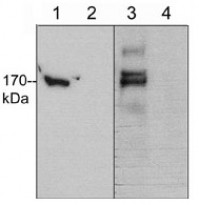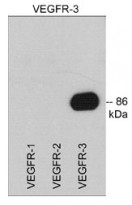ARG20581
anti-FLT4 / VEGFR3 antibody
anti-FLT4 / VEGFR3 antibody for Western blot and Human
Cancer antibody; Cell Biology and Cellular Response antibody; Gene Regulation antibody; Signaling Transduction antibody
Overview
| Product Description | Rabbit Polyclonal antibody recognizes FLT4 / VEGFR3 |
|---|---|
| Tested Reactivity | Hu |
| Predict Reactivity | Rat |
| Tested Application | WB |
| Specificity | This antibody detects a ~170 kDa band corresponding to VEGFR-3 in western blots of human endothelial and K-562 cells, and shows strong reactivity to recombinant human VEGFR-3, but not VEGFR-1 or VEGFR-2. |
| Host | Rabbit |
| Clonality | Polyclonal |
| Isotype | IgG |
| Target Name | FLT4 / VEGFR3 |
| Antigen Species | Human |
| Immunogen | Synthetic peptide (coupled to carrier protein) around aa. 1285-1298 of Human VEGFR-3. This sequence has two aa. differences of Rat VEGFR-3, and five aa. differences of Mouse VEGFR-3. |
| Conjugation | Un-conjugated |
| Alternate Names | FLT-4; FLT41; Vascular endothelial growth factor receptor 3; VEGFR3; VEGFR-3; PCL; Tyrosine-protein kinase receptor FLT4; LMPH1A; EC 2.7.10.1; Fms-like tyrosine kinase 4 |
Application Instructions
| Application Suggestion |
|
||||
|---|---|---|---|---|---|
| Application Note | WB: Antibody is suggested to be diluted in 5% skimmed milk/Tris buffer with 0.04% Tween20 and incubated for 1 hour at room temperature. * The dilutions indicate recommended starting dilutions and the optimal dilutions or concentrations should be determined by the scientist. |
Properties
| Form | Liquid |
|---|---|
| Purification | Affinity purification with immunogen. |
| Buffer | 100 μl PBS, 0.05% Sodium azide, 50% Glycerol and 1 mg/ml BSA |
| Preservative | 0.05% Sodium azide |
| Stabilizer | 50% Glycerol, 1 mg/ml BSA |
| Storage Instruction | For continuous use, store undiluted antibody at 2-8°C for up to a week. For long-term storage, aliquot and store at -20°C. Storage in frost free freezers is not recommended. Avoid repeated freeze/thaw cycles. Suggest spin the vial prior to opening. The antibody solution should be gently mixed before use. |
| Note | For laboratory research only, not for drug, diagnostic or other use. |
Bioinformation
| Database Links |
Swiss-port # P35916 Human Vascular endothelial growth factor receptor 3 |
|---|---|
| Gene Symbol | FLT4 |
| Gene Full Name | fms-related tyrosine kinase 4 |
| Background | This gene encodes a tyrosine kinase receptor for vascular endothelial growth factors C and D. The protein is thought to be involved in lymphangiogenesis and maintenance of the lymphatic endothelium. Mutations in this gene cause hereditary lymphedema type IA. [provided by RefSeq, Jul 2008] |
| Function | Tyrosine-protein kinase that acts as a cell-surface receptor for VEGFC and VEGFD, and plays an essential role in adult lymphangiogenesis and in the development of the vascular network and the cardiovascular system during embryonic development. Promotes proliferation, survival and migration of endothelial cells, and regulates angiogenic sprouting. Signaling by activated FLT4 leads to enhanced production of VEGFC, and to a lesser degree VEGFA, thereby creating a positive feedback loop that enhances FLT4 signaling. Modulates KDR signaling by forming heterodimers. The secreted isoform 3 may function as a decoy receptor for VEGFC and/or VEGFD and play an important role as a negative regulator of VEGFC-mediated lymphangiogenesis and angiogenesis. Binding of vascular growth factors to isoform 1 or isoform 2 leads to the activation of several signaling cascades; isoform 2 seems to be less efficient in signal transduction, because it has a truncated C-terminus and therefore lacks several phosphorylation sites. Mediates activation of the MAPK1/ERK2, MAPK3/ERK1 signaling pathway, of MAPK8 and the JUN signaling pathway, and of the AKT1 signaling pathway. Phosphorylates SHC1. Mediates phosphorylation of PIK3R1, the regulatory subunit of phosphatidylinositol 3-kinase. Promotes phosphorylation of MAPK8 at 'Thr-183' and 'Tyr-185', and of AKT1 at 'Ser-473'. [UniProt] |
| Research Area | Cancer antibody; Cell Biology and Cellular Response antibody; Gene Regulation antibody; Signaling Transduction antibody |
| Calculated MW | 153 kDa |
| PTM | Autophosphorylated on tyrosine residues upon ligand binding. Autophosphorylation occurs in trans, i.e. one subunit of the dimeric receptor phosphorylates tyrosine residues on the other subunit. Phosphorylation in response to H(2)O(2) is mediated by a process that requires SRC and PRKCD activity. Phosphorylation at Tyr-1068 is required for autophosphorylation at additional tyrosine residues. Phosphorylation at Tyr-1063 and Tyr-1337 is important for interaction with CRK and subsequent activation of MAPK8. Phosphorylation at Tyr-1230, Tyr-1231 and Tyr-1337 is important for interaction with GRB2 and subsequent activation of the AKT1 and MAPK1/ERK2 and/or MAPK3/ERK1 signaling pathways. In response to endothelial cell adhesion onto collagen, can also be phosphorylated in the absence of FLT4 kinase activity by SRC at Tyr-830, Tyr-833, Tyr-853, Tyr-1063, Tyr-1333, and Tyr-1337. |
Images (2) Click the Picture to Zoom In
-
ARG20581 anti-FLT4 / VEGFR3 antibody WB image
Western blot: K-562 cells (lanes 1, 2) and HUVEC (lanes 3, 4) stained with ARG20581 anti-FLT4 / VEGFR3 antibody in the absence (lanes 1, 3) or presence of blocking peptide (lanes 2, 4).
-
ARG20581 anti-FLT4 / VEGFR3 antibody WB image
Western blot: GST-recombinant Human VEGFR-1 (89 kDa), VEGFR-2 (110 kDa), and VEGFR-3 (86 kDa) C-terminal regions. The blot was stained with ARG20581 anti-FLT4 / VEGFR3 antibody.







